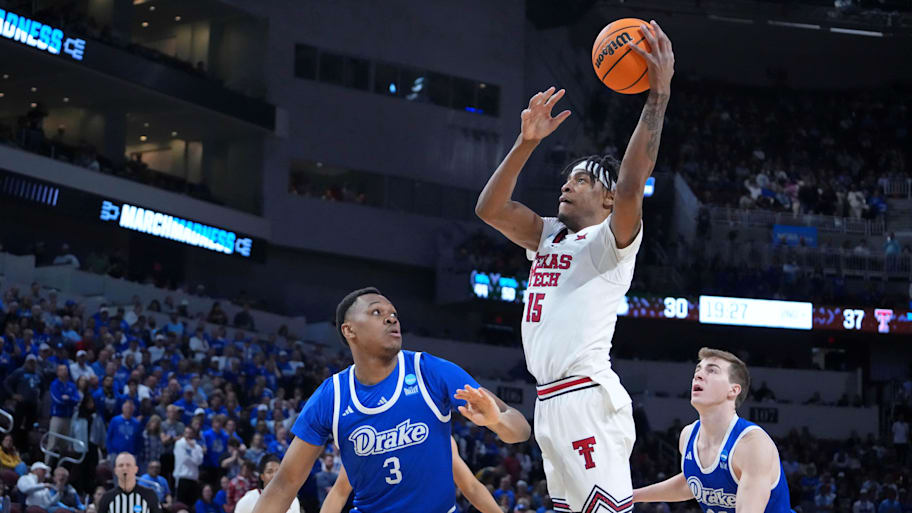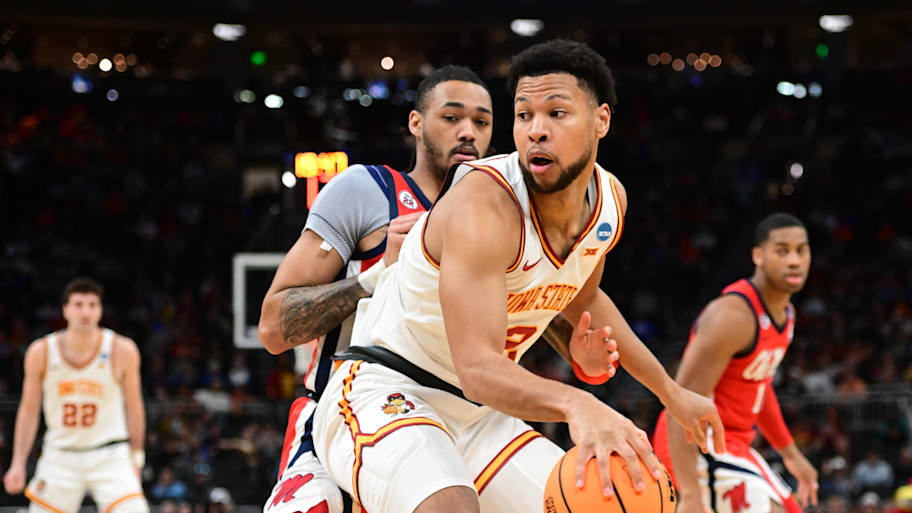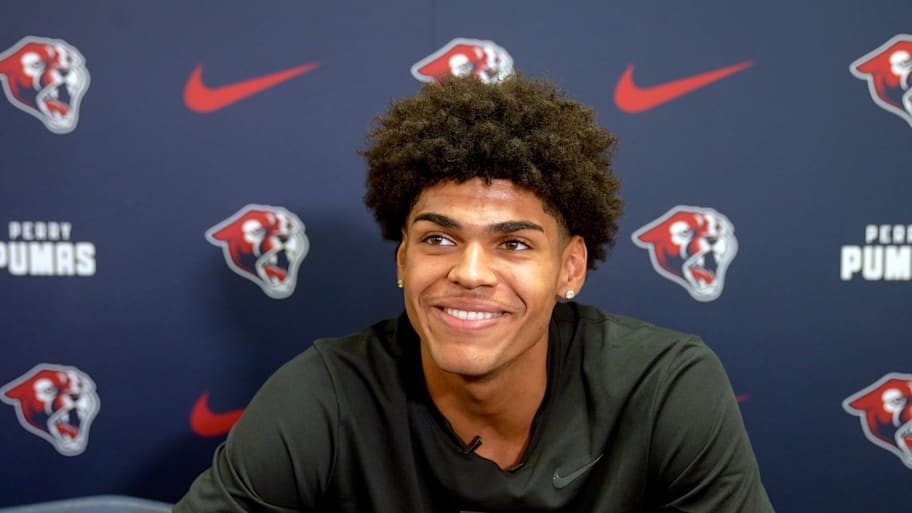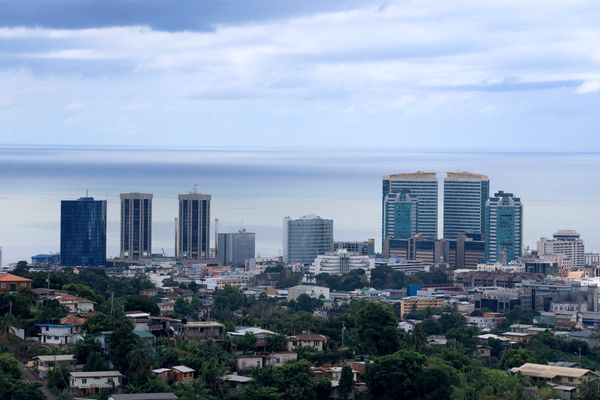
This week, Sports Illustrated is rolling out its college basketball player rankings by position. Grouping players into traditional position groups in the era of positionless basketball is always a challenge, though SI’s rankings are largely based on where a player projects to play the majority of his minutes this season (with a few exceptions). From elite freshmen to top transfers and potential breakout stars, the player pool for these rankings was deep. So far in the series, we ranked point guards, shooting guards and small forwards. We continue today with power forwards.
1. JT Toppin, Texas Tech
Toppin’s return to Texas Tech for his junior year is a boon for college basketball. The 6' 9" big man is a double-double machine and led Texas Tech’s run to the Elite Eight last season. He produces at an elite level without needing a ton of set plays drawn up for him, and his motor on the glass is as good as anyone in college hoops. Expect to see him more at the four this season with VCU transfer Luke Bamgboye providing a lift as a rim-protecting five.
2. Cameron Boozer, Duke
The son of longtime NBA forward Carlos, Cameron Boozer has consistently outproduced everyone in his loaded high school class throughout a decorated prep career. He’s such a well-rounded modern big, a beast on the glass and around the rim who has continued to expand his game to be able to shoot from the perimeter, handle the ball and lead the break. Expect huge numbers in what should be his lone season at Duke.
3. Trey Kaufman-Renn, Purdue
Kaufman-Renn predictably exploded as a junior after Zach Edey’s graduation left a massive hole in the Boilermakers’ frontcourt. Kaufman-Renn does it a bit differently than the Boilers’ traditional towering bigs, using elite skill and footwork to create angles and an impressive face-up game to attack mismatches. His return is a huge reason why there’s so much optimism in West Lafayette, Ind., about the Boilermakers making a national title push.
4. Yaxel Lendeborg, Michigan
Few stuff the stat sheet like Lendeborg, the transfer from UAB who averaged over 17 points, 11 rebounds and four assists per game a season ago for the Blazers. He spurned serious interest in the back half of the first round to head to Ann Arbor, Mich., where Dusty May will help him solidify his standing as a potential top-20 pick. It will be interesting to see how much May looks to Lendeborg to initiate offense, something he did a lot of at UAB.
5. Joshua Jefferson, Iowa State
Jefferson was quietly one of the most important portal additions of last season, averaging north of 13 points, seven rebounds and three assists per game for Iowa State in 2024–25. He provided a huge boost to an Iowa State offense that previously under T.J. Otzelberger had struggled to get consistent offensive production from its frontcourt. Transfers have been known to jump from good to great in their second year in a system (Curtis Jones last season is a prime example), and it wouldn’t be a surprise to see Jefferson do just that this season.

6. Bryce Hopkins, St. John’s
Hopkins played in just four games in the calendar year 2024 after tearing his ACL on Jan. 3 and then shutting things down early in the 2024–25 season after attempting to return. He should be back to full health now though, and vintage Hopkins is a surefire all-conference guy in the Big East. He’s a monster on the boards who’s a load to handle when he gets a head of steam going to the rim. He should fit right in next to Zuby Ejiofor in the Red Storm frontcourt.
7. Alex Condon, Florida
A key part of the Gators’ national title team, Condon tested the draft but eventually decided to return for his junior season in Gainesville, Fla. He’s such a valuable piece for how Todd Golden’s teams want to play, with the toughness to scrap inside with some of the toughest bigs in the country but also the skill level to make plays on the perimeter as a four-man. He’s still relatively new to basketball and has improved this offseason as a shooter.
8. Alex Karaban, UConn
The 2024–25 season was a down year from an efficiency standpoint for Karaban, who saw his shooting percentages drop across the board while taking on a bigger offensive role for a Huskies team that failed to reach the heights of his first two seasons in Storrs, Conn. With high-profile additions like Silas Demary Jr. and Braylon Mullins joining the fray in the backcourt, Karaban’s role should look more like what it did on the two title-winning teams … and that’s a great sign for UConn’s hopes of getting back to the Final Four.
9. Joseph Tugler, Houston
Tugler will likely never light up the stat sheet on the offensive end of the floor, but he has perhaps the most impact of any defender in the country. His absurd 7' 6" wingspan makes him incredibly disruptive around the rim, and that combined with his impressive mobility on the perimeter makes him a huge weapon for Houston’s perennially elite defense.
10. Thijs De Ridder, Virginia
De Ridder is a name only college hoops diehards are familiar with right now, but he could be a household name by March. The Belgian forward has experience starting in the Spanish ACB, one of the best leagues in the world, and has been a fixture with Belgium’s national team in recent years. He’s a well-rounded frontcourt player with toughness, versatility and touch who has a chance to be Virginia’s best player this season.

11. Koa Peat, Arizona
Peat is the type of slightly undersized bruising four-man that tends to be highly effective in college basketball. He’s a load to handle on the block and has an outstanding face-up game from the mid-post. He should be heavily featured in Arizona’s offense, which will value his ability to score in isolation and play high-low basketball.
12. Nick Martinelli, Northwestern
Martinelli has seen his scoring average jump from 2.6 as a freshman to 8.8 as a sophomore to more than 20 per game as a junior. Now, he’s back for his senior season in Evanston, Ill., looking to lift the Wildcats to a third NCAA tournament appearance in his career. His game is unorthodox, featuring a variety of funky-looking push shots, post buckets and midrange iso-ball … but it works! Expect him to be one of the Big Ten’s leaders in scoring.
13. Malik Dia, Ole Miss
Dia is a highly skilled frontcourt player who should see most of his time at the four this season after the Rebels beefed up their frontcourt in the portal this spring. At his best, he’s a near-impossible cover because he can stretch the floor, put the ball on the deck and score on the block. Consistency has been a problem at times, but Dia’s ceiling is so high when he’s firing on all cylinders.
14. Tyler Bilodeau, UCLA
Bilodeau had a great first season in Westwood, shooting a career-best 40% from three and providing a much-needed offensive jolt to a team that was sluggish at times on that end of the floor. How his role evolves playing with an elite point guard in Donovan Dent will be fascinating to watch.
15. Devin McGlockton, Vanderbilt
Vanderbilt’s roster was undersized a year ago, and McGlockton’s ability to handle much bigger SEC frontcourts was a huge reason for the Commodores’ surprise trip to the NCAA tournament. The Boston College transfer is a beast on the offensive glass and shot over 70% at the rim last season.
Honorable Mention
- Caleb Wilson, North Carolina
- Braden Huff, Gonzaga
- Keyshawn Hall, Auburn
- Robbie Avila, Saint Louis
- Michael Rataj, Baylor
- Mo Dioubate, Kentucky
- Mark Mitchell, Missouri
- Paulius Murauskas, Saint Mary’s
- Nick Davidson, Clemson
- Malik Reneau, Miami
More College Basketball on Sports Illustrated
Listen to SI’s new college sports podcast, Others Receiving Votes, below or on Apple and Spotify. Watch the show on SI’s YouTube channel.
This article was originally published on www.si.com as Ranking the 15 Best Power Forwards in Men’s College Basketball for 2025.







